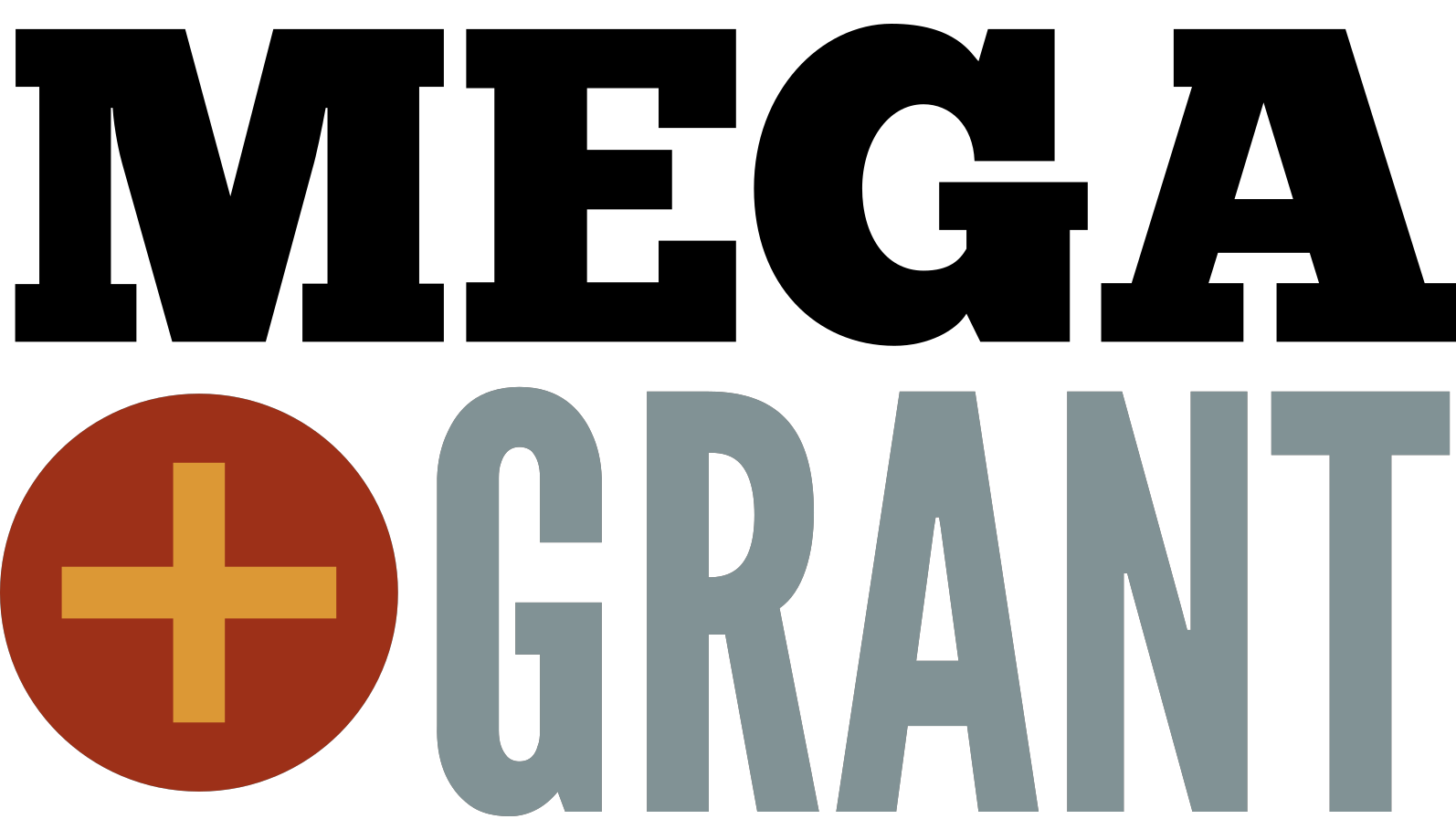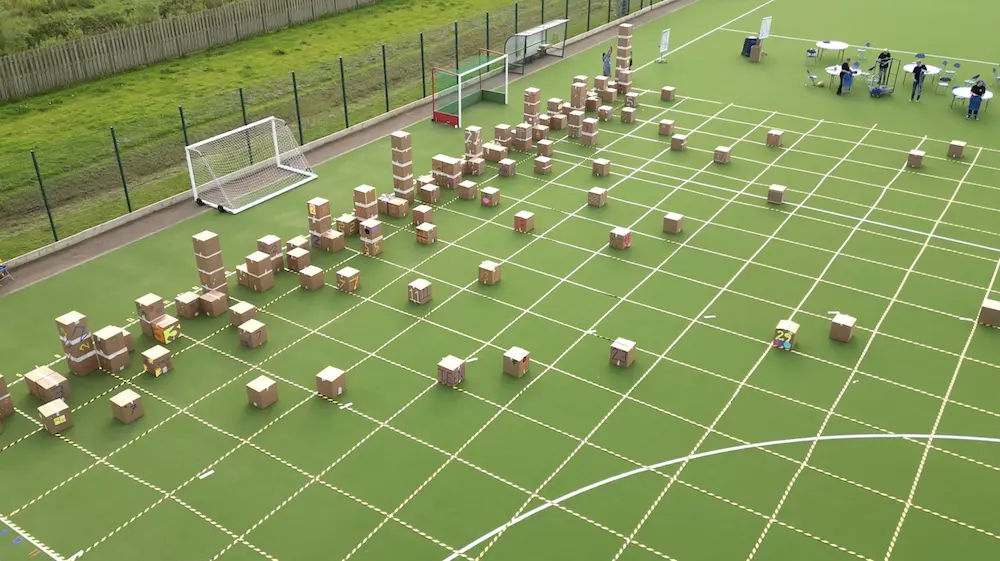



The MEGA Grant for 2025/6 has been awarded to Beach Spectres.

The aperiodic monotile was an unexpected discovery in 2023, and there have been several demonstrations constructing it in real life, such as the foam tiles produced for TMiP 2023. But making individual tiles limits you to the number of pieces you have.
Beaches are big and (mainly) flat and, famously, easy to do a bit of ephemeral building on. We're going to make large “cookie cutter” tools in the shape of the spectre monotile, and cover a beach with the aperiodic tiling. There may also be ice cream.
The project is currently in the early planning stage. Once we've picked a time and a place, we'll be looking for volunteers to come down to the beach and do some aperiodic tiling, and talk to the public about what we're doing. If you're interested in being involved, join the ridiculous maths project volunteer mailing list, and we'll contact you when we're looking for people.
The MEGA Grant is a bursary scheme for mathematical public engagement activities, with funding organised by Stand-up Mathematician Matt Parker and coordinated by TMiP (Talking Maths in Public), the UK’s network for maths communicators. The grant will be awarded every two years to a mathematician or maths communicator, to fund a maths activity taking place in the UK.
Matt has been involved in a variety of large-scale public engagement activities in the past, and would like to offer others the chance to bring in their own ideas and perspectives.
The concept is based on three revolutionary principles, summarised as RPM (Ridiculous Public Maths):
The activities will normally run as part of a science festival or other large-scale event, and be aimed at a science festival audience - consisting of adults, children and family groups, usually with a pre-engaged disposition to maths and science. Activities may be targeted at specific sub-audiences or age ranges within this - for example, some activities may be more suitable for older children as they require a higher level of mathematical understanding or development - although activities which incorporate ways for a variety of audiences to engage are encouraged. Applicants can, if needed, be connected with a maths/science festival or event (and potentially a project manager) by Matt/the MEGA admin, depending on preference, timing and suitability of the activity.
The grant application process will be administered by TMiP, and applications can be made through an online form. Applications including information that identifies the applicant will have this information removed for anonymisation purposes before circulating to the panel for their initial discussions, then later added back in - it's fine to include this kind of detail, but please do so in a way that means it can be easily anonymised as needed. Applications are currently closed, and will reopen in 2027.
Applications for the grant will be via an online form, and a panel including Matt, members of the TMiP committee and other maths communication experts will decide on which projects receive funding. Members of the TMiP committee who anticipate they may be involved in one or more of the applicants’ projects may be recused from the panel. TMiP committee members are not themselves allowed to be the lead applicant on any grant.
Discussions of the applications will be initially conducted anonymously, followed by a later round of discussion of deanonymised applications, with the goal of balancing the diversity of applications and ensuring applications from early-career communicators are given sufficient consideration. The winner will be announced at the Talking Maths in Public conference, which takes place every two years at the end of August - although the winner may be notified sooner.
The grant will cover costs of between £2,000 - £10,000 depending on the requirements of the activity. This funding should be used to cover material and equipment costs for the activity and any expenses, as well as a fee for the time of the applicant organising the activity to cover their work on delivery and preparation. The project should aim to strike a balance between producing a high-quality event without cutting corners, and keeping costs reasonable - ‘ridiculous’ should apply to the activity, not the budget. Funding will be coordinated via TMiP, with money being provided upfront where needed to cover costs, and receipts needed to claim any expenses.
The application may be a complete well-formed idea, or something more preliminary, and the awardee will have the chance to meet with Matt and other experienced providers of large-scale maths activities for advice and to help plan the final activity. They will receive advice on sourcing materials and equipment, activity design, and contacts for outsourcing graphic/web design work or fabrication. Matt’s network of mathematical activity volunteers may be deployed in support of the activity, or the awardee can organise their own team of volunteers.
Details of Matt’s previous large-scale ridiculous public maths projects (see above) will be available for applicants to get a sense of what’s possible - including information about budgets, organisation and production. These events should not be taken as a blueprint for what type of activity to do - these kinds of activities have proven to be successful in the past, but ideas with a completely different approach will also be considered and are encouraged.
Matt reserves the right to come along and join in with the activity if availability permits, and may also make a video for the Stand-up Maths YouTube channel if appropriate.
Funding for the grant may also involve sponsorship from external bodies or organisations, and all supporting organisations (Stand-up Maths Limited, Talking Maths in Public and any others) will need to be given credit in promotion for the event - this will likely involve including their logos on printed materials and web content as appropriate.
Applications can bend or ignore any of the MEGA Grant rules and requirements as long as they explain why.
The MEGA Grant for 2023/4 was awarded to Number City.

Every whole number can be written uniquely as a product of its prime factors - 4 is 2 × 2, 12 is 2 × 2 × 3 and 1790 is 2 × 5 × 179. Splitting numbers and writing them in this way is useful for mathematicians to understand the properties of a number - for example, any number which has a factor of 2 is an even number, and numbers which only have factors of 2 are powers of two. The Number City project made these prime factorisations visible, by building a tower of blocks for each prime.
Imagine the City as a grid of rows and columns, with a column for each number, and a row for each potential prime factor. For a number p that is itself prime, the corresponding column of Number City would contain only one block, in the pth row. But for numbers with more complicated factorisations, each factor is represented by a separate cube: 12 would be a stack of 2 boxes in row 2, and one box in row 3. The number 120 would need 5 boxes - 3 in row 2, one in row 3 and one in row 5.

We planned to represent all numbers up to 128 (in practice we made it up to 64), and used 50cm cube-shaped cardboard boxes for each prime factor, arranged in a large outdoor space. Participants were invited to create and personalise a box for a particular factor, then placed it in the city to form part of the installation. The patterns visible in the arrangement of boxes reflected the patterns present in numbers and their relationships with their prime factors, and looking at the city from different directions allowed participants and visitors to visualise mathematical ideas. Activity resources for schools and families were made available, and you can use this Geogebra applet to explore a 3D model of the City.
The original idea for Number City was conceived by Paul Stephenson, who was around on the day to talk to participants.
Matt Parker said:
“We liked Paul Stephenson's Number City because it had the potential to work on a large scale in a way that would emphasise the maths, and wasn't just for the sake of being big. Being able to walk around the towers of factors will help to show the structure in them.
Even with no additional guidance, Number City will make people think mathematical thoughts. Even if someone knew it was a number line, walking through (or helping build) Number City will organically make them wonder and ask the same sorts of questions about the positions of the towers that mathematicians ask about numbers.”
Number City took place at the Orkney International Science Festival on Saturday 7th September 2024, and the project was managed by Hana Ayoob. To find out more about the project, visit the Number City website.
The project was filmed for Matt Parker's Stand-up Maths YouTube channel, and the video is now available on the Matt_Parker_2 channel.